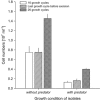Letting go: bacterial genome reduction solves the dilemma of adapting to predation mortality in a substrate-restricted environment
- PMID: 28585936
- PMCID: PMC5607369
- DOI: 10.1038/ismej.2017.87
Letting go: bacterial genome reduction solves the dilemma of adapting to predation mortality in a substrate-restricted environment
Abstract
Resource limitation and predation mortality are major determinants of microbial population dynamics, and optimization for either aspect is considered to imply a trade-off with respect to the other. Adaptation to these selective factors may, moreover, lead to disadvantages at rich growth conditions. We present an example of a concomitant evolutionary optimization to both, substrate limitation and predation in an aggregate-forming freshwater bacterial isolate, and we elucidate an underlying genomic mechanism. Bacteria were propagated in serial batch culture in a nutrient-restricted environment either with or without a bacterivorous flagellate. Strains isolated after 26 growth cycles of the predator-prey co-cultures formed as much total biomass as the ancestor at ancestral growth conditions, albeit largely reallocated to cell aggregates. A ~273 kbp genome fragment was lost in three strains that had independently evolved with predators. These strains had significantly higher growth yield on substrate-restricted media than others that were isolated from the same treatment before the excision event. Under predation pressure, the isolates with the deletion outcompeted both, the ancestor and the strains evolved without predators even at rich growth conditions. At the same time, genome reduction led to a growth disadvantage in the presence of benzoate due to the loss of the respective degradation pathway, suggesting that niche constriction might be the price for the bidirectional optimization.
Conflict of interest statement
The authors declare no conflict of interest.
Figures





Similar articles
-
Protistan predation interferes with bacterial long-term adaptation to substrate restriction by selecting for defence morphotypes.J Evol Biol. 2016 Nov;29(11):2297-2310. doi: 10.1111/jeb.12957. Epub 2016 Sep 1. J Evol Biol. 2016. PMID: 27488245
-
Aggregate formation in a freshwater bacterial strain induced by growth state and conspecific chemical cues.Environ Microbiol. 2010 Sep;12(9):2486-95. doi: 10.1111/j.1462-2920.2010.02222.x. Epub 2010 Apr 19. Environ Microbiol. 2010. PMID: 20406293
-
Structural and functional patterns of bacterial communities in response to protist predation along an experimental productivity gradient.Environ Microbiol. 2008 Oct;10(10):2857-71. doi: 10.1111/j.1462-2920.2008.01713.x. Epub 2008 Aug 5. Environ Microbiol. 2008. PMID: 18684120
-
Predation on prokaryotes in the water column and its ecological implications.Nat Rev Microbiol. 2005 Jul;3(7):537-46. doi: 10.1038/nrmicro1180. Nat Rev Microbiol. 2005. PMID: 15953930 Review.
-
Upflow anaerobic sludge blanket reactor--a review.Indian J Environ Health. 2001 Apr;43(2):1-82. Indian J Environ Health. 2001. PMID: 12397675 Review.
Cited by
-
Zooplankton as a Transitional Host for Escherichia coli in Freshwater.Appl Environ Microbiol. 2022 May 10;88(9):e0252221. doi: 10.1128/aem.02522-21. Epub 2022 Apr 13. Appl Environ Microbiol. 2022. PMID: 35416683 Free PMC article.
-
Divergent paths in the evolutionary history of maternally transmitted clam symbionts.Proc Biol Sci. 2022 Mar 9;289(1970):20212137. doi: 10.1098/rspb.2021.2137. Epub 2022 Mar 9. Proc Biol Sci. 2022. PMID: 35259985 Free PMC article.
-
Model Microbial Consortia as Tools for Understanding Complex Microbial Communities.Curr Genomics. 2018 Dec;19(8):723-733. doi: 10.2174/1389202919666180911131206. Curr Genomics. 2018. PMID: 30532651 Free PMC article. Review.
-
Pseudomonas aeruginosa MutL promotes large chromosomal deletions through non-homologous end joining to prevent bacteriophage predation.Nucleic Acids Res. 2018 May 18;46(9):4505-4514. doi: 10.1093/nar/gky160. Nucleic Acids Res. 2018. PMID: 29514250 Free PMC article.
-
Bacterial community composition responds to changes in copepod abundance and alters ecosystem function in an Arctic mesocosm study.ISME J. 2018 Nov;12(11):2694-2705. doi: 10.1038/s41396-018-0217-7. Epub 2018 Jul 10. ISME J. 2018. PMID: 29991763 Free PMC article.
References
-
- Altschul SF, Gish W, Miller W, Myers EW, Lipman DJ. (1990). Basic local alignment search tool. J Mol Biol 215: 403–410. - PubMed
-
- Andersson SGE, Zomorodipour A, Andersson JO, Sicheritz-Ponten T, Alsmark UCM, Podowski RM et al. (1998). The genome sequence of Rickettsia prowazekii and the origin of mitochondria. Nature 396: 133–140. - PubMed
-
- Baas-Becking LGM. (1934) Geobiologie; of inleiding tot de milieukunde. WP Van Stockum & Zoon NV: The Hague, The Netherlands.
MeSH terms
LinkOut - more resources
Full Text Sources
Other Literature Sources

